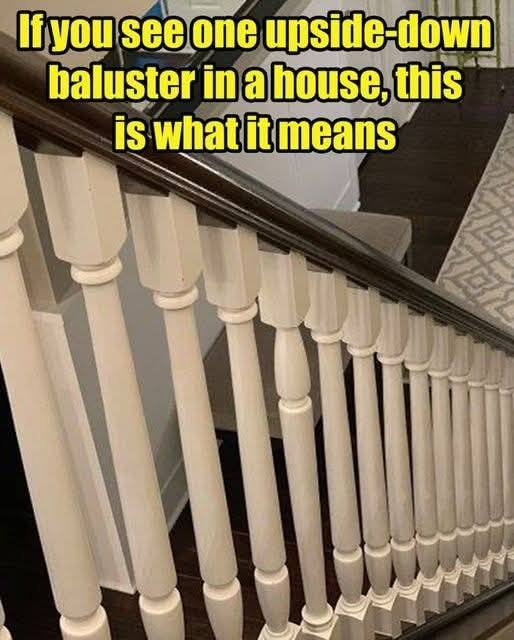
If one subscribes to folklore, it may be reassuring to learn that the upside-down baluster on the stairway banister is believed to prevent malevolent spirits from residing in the upper levels of your residence.
Conversely, if you do not adhere to superstitions, you might find the asymmetry introduced by the inverted vertical post to be merely an annoyance, despite its intriguing historical context.
In the realm of architecture and construction, where skill and precision converge with artistic expression, age-old customs and beliefs frequently influence the process, blending functionality with an element of intrigue.
Among these captivating traditions is the practice of carpenters deliberately installing one baluster—vertical supports for the handrail—upside down within a staircase.
While this choice may disrupt the staircase’s overall symmetry, it is, in fact, a tradition steeped in historical importance.
Spiritual significance
As reported by the Long Island Press, the origins of this superstition can be traced back centuries, to an era when architecture and spirituality were closely linked. Staircases, serving as connections between various levels of a structure, were often perceived as symbolic conduits between the physical and spiritual realms. Within this belief framework, staircases were thought to act as potential passageways for spirits—both benevolent and malevolent—traversing between worlds.
To protect against the potential threat posed by malevolent spirits, carpenters implemented the custom of placing a single upside-down spindle within an otherwise uniform staircase balustrade. This intentional inversion is rooted in the belief that evil entities could only traverse in straight, unbroken lines. It was thought that by disrupting the pattern with an inverted spindle, these entities would be deterred from ascending to the living areas above.
This symbolic imperfection is also believed to have been embraced by religious artisans as a recognition that only a divine being embodies perfection. Thus, this practice served as a modest reminder of human imperfection.
Themes of duality and balance
In addition to its supernatural implications, the upside-down spindle embodies concepts of duality and balance. A staircase inherently signifies a transition between two states—ascending and descending, one level to another. The inclusion of an asymmetrical element, such as the inverted spindle, introduces a purposeful balance to the overall design. This subtle flaw reflects the harmony sought in both the physical structure and the spiritual safeguarding it was intended to offer.
Prevalence in historic homes
The presence of the inverted baluster is more widespread than one might assume. In 2020, Scott McGillivray, a host on HGTV and DIY Network, generated interest on Facebook by sharing an image of a staircase railing that featured a single upside-down baluster positioned near the center of the banister.
He captioned the post, “One of these things is not like the other,” which elicited thousands of reactions from intrigued followers.
Some individuals proposed that it was a celebration of human imperfections: “It is common in old houses. The carpenter acknowledged that only God is perfect, so he intentionally placed one spindle upside down to create an imperfection,” noted one user. Another commented, “This practice was common among religious individuals who believed that creating something flawless was akin to competing with God. It symbolized humility before the divine.”
Among the responses, a few perceived it as an error: “Oh man! Perhaps they ran out and are hoping the different one won’t be too noticeable,” remarked one, while another added, “Mistakes do occur!”
Others expressed that it triggered their obsessive-compulsive tendencies: “This would likely keep me awake at night,” one user stated, and another remarked, “No one with OCD could live in that house! That would drive me insane!”
These architectural anomalies offer more than mere visual intrigue; they provide insight into the values, beliefs, and daily lives of those who lived in earlier centuries. For contemporary homeowners and architecture aficionados, they serve as poignant reminders of the rich tapestry of human history woven into the buildings we occupy.
Therefore, the next time you ascend a staircase, take a moment to examine the balusters closely. You may find yourself standing on a piece of history, where every detail narrates a story.



